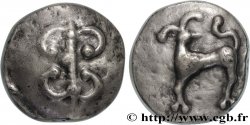Live auction - bga_827657 - HELVETII (Currently Switzerland) Denier épigraphe VVV à la palme
You must signin and be an approved bidder to bid, LOGIN TO BID. Accounts are subject to approval and the approval process takes place within 48 hours. Do not wait until the day a sale closes to register. Clicking on "BID" constitutes acceptance of the terms of use of cgb.fr private live auctions.
Bids must be placed in whole Euro amounts only. The sale will start closing at the time stated on the item description; any bids received at the site after the closing time will not be executed. Transmission times may vary and bids could be rejected if you wait until the last second. For further information check the Live auction FAQ
All winning bids are subject to a 18% buyer’s fee.
All winning bids are subject to a 18% buyer’s fee.
| Estimate : | 300 € |
| Price : | no bid |
| Maximum bid : | no bid |
| End of the sale : | 25 July 2023 16:14:07 |
Type : Denier épigraphe VVV à la palme
Date: c. 80-50 AC.
Metal : silver
Diameter : 13 mm
Orientation dies : 2 h.
Weight : 1,42 g.
Rarity : R3
Coments on the condition:
Flan court et légèrement décentré. Flan usé au revers, on devine cependant la légende VVV sous le cheval. Patine grise
Catalogue references :
Obverse
Obverse legend : ANÉPIGRAPHE.
Obverse description : Palmes de part et d’autre d’un axe verticale bouleté.
Reverse
Reverse legend : VVV DANS UN CARTOUCHE.
Reverse description : Cheval passant à gauche ; une volute au-dessus du dos et la légende entre les jambes.
Commentary
Ce denier appartient à la rare série des monnaies épigraphes à la palme. Le HMZ recense quelques rares monnaies avec cet avers associé à un revers épigraphe.
Notre denier se rapproche du 1-42 avec une légende VVV correspondant à peu près à VM ou MV, mais dans un cartouche.
Notre denier se rapproche du 1-42 avec une légende VVV correspondant à peu près à VM ou MV, mais dans un cartouche.








 Report a mistake
Report a mistake Print the page
Print the page Share my selection
Share my selection Ask a question
Ask a question Consign / sell
Consign / sell
 Full data
Full data















